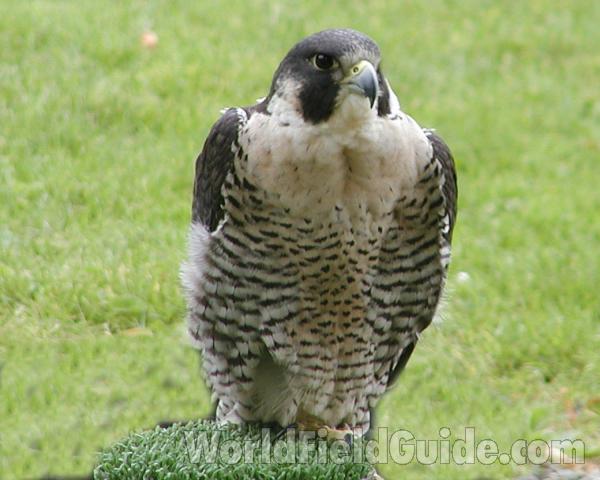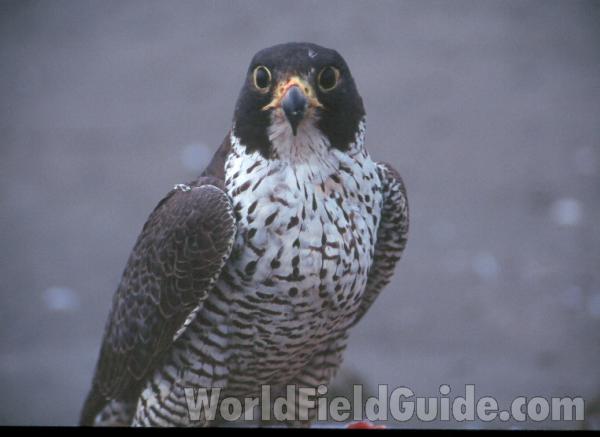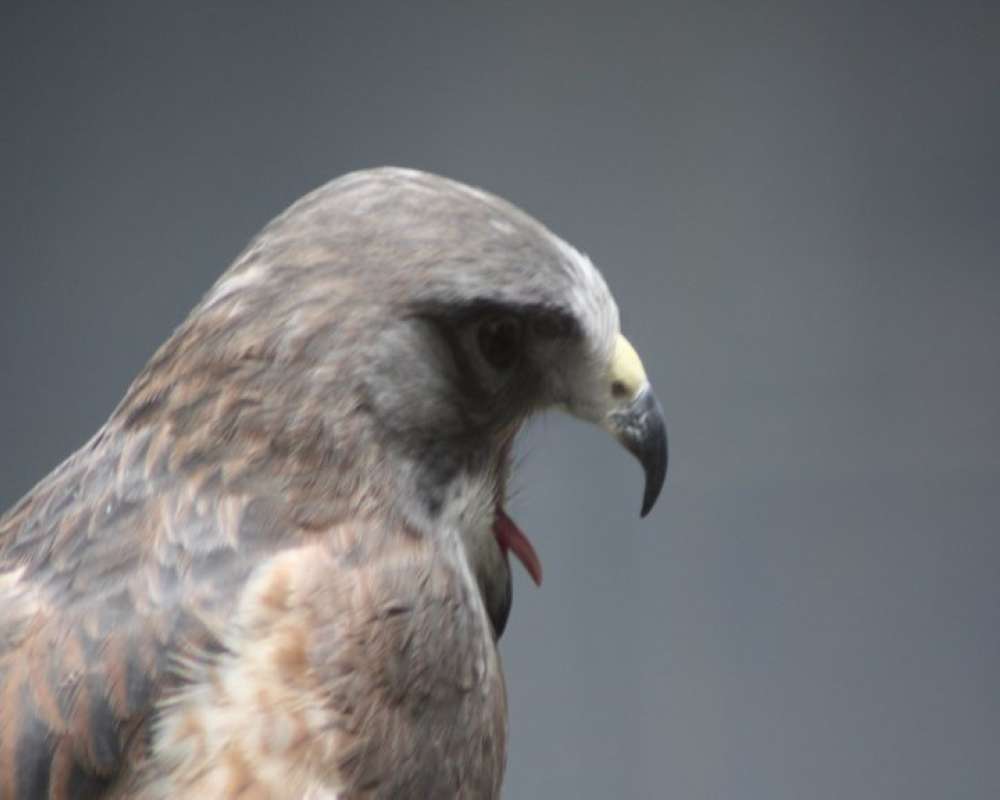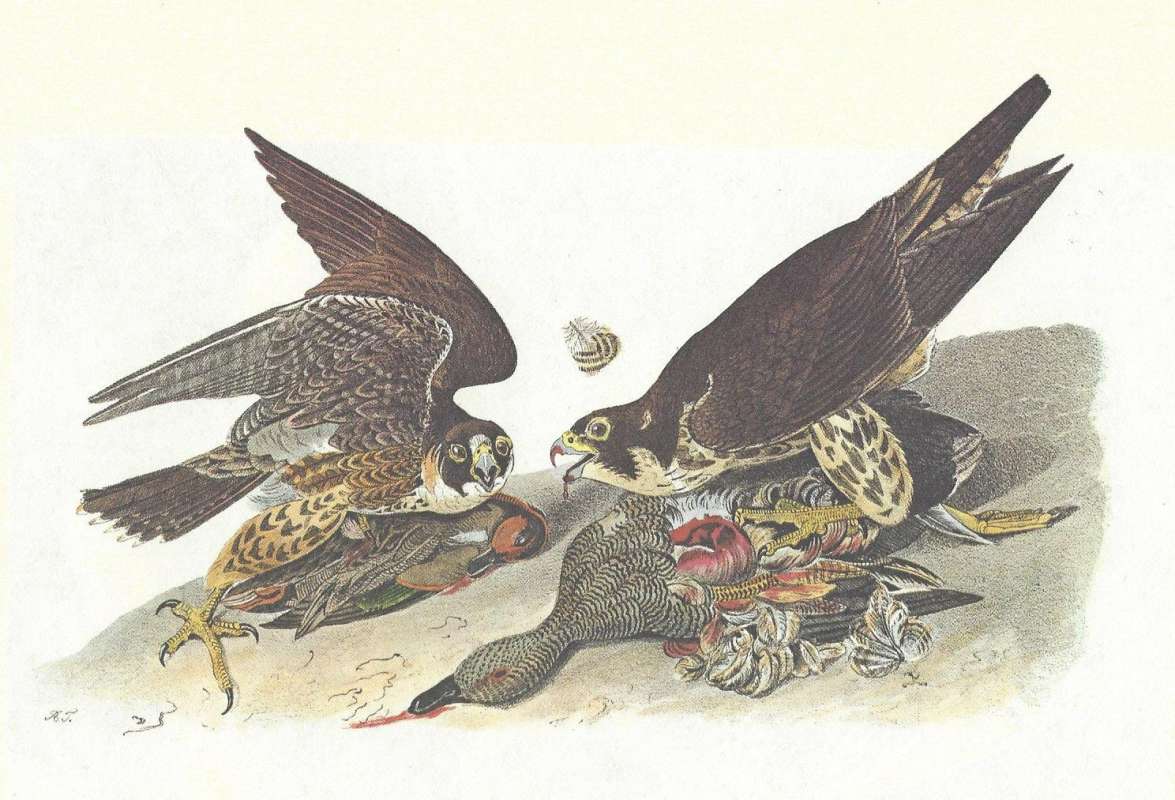SPECIES INFO
Peregrine Falcon or Duck Hawk (Falco peregrinus) is found in Australia, southern African, Eurasia, and North America and, in winter, south into Argentina and Chile. The Peregrine is about twenty inches long with a wingspan of about three and one half feet. The wings are black and white, and the upper breast is white. This falcon can be from 15 inches (male) to 20 inches (female).
In spite of its wide range, the Peregrine is considered endangered. Estimates of its North American population, as published in Collins ICBP handbook, indicate a limited number of birds in Alaska and very few in western North America. Captive breeding programs are underway with releases in various parts of the United States.
The peregrine falcon has about 18 recognized subspecies. We list the four subspecies found in the New World.
F. p. tundrius - Arctic from Alaska to Greenland
F. p. anatum - Most of North America to Mexico
F. p. pealei - Coastal western N. America south to Washington
F. p. cassini - Ecuador to southern Chile to Falkland IslesThe falcon genus (Falco) is found almost world wide. These are small hawk like birds generally less than 24 inches in length, although most are less than 18 inches in length. There are about 38 species in this genus. These birds generally catch their prey on the wing.
Falcons (Family Falconidae) contains the Caracaras and the Falcons. There are over sixty species in this family. Several sub-families are noted:
Polyborinae Group
Herpetotherinae - live on reptiles - about 5-7 species
Polyborinae -caracara-feed on carrion - about 9-11 species
Falconinae Group
Poliohieracinae - small insect eaters - about 8-9 species
Falconinae - typical falcons - about 35-38 species
Birds of Prey (Order Falconiformes) group contains the eagles, hawks, falcons, Old World vultures, and related birds. The majority of the species in this group feed on small animals, fish, and other birds. A few species eat dead animals. Most of them are excellent fliers and have very strong legs and claws for grasping their prey. There are about 239 species in the hawk and eagle group and about 61 species in the falcon group. When you include the unique osprey and the unique secretary bird, you total about 302 species more or less depending upon a few controversial subspecies.
(The 7 species of New World vultures have recently been placed near the pelicans and storks and were not counted in our 302 number. However, for historical reasons we have left those vultures below here, as our purpose is defining species, and helping users navigate the large number of species.)
Aves contains about 8,650 different species of living birds known to science. Each year about one new species is discovered in some remote rain forest or remote island. In addition, scientists have been raising many subspecies to full species status which may raise the species count to 10,000. Birdlife recognizes 10,027 species as of 2011.
However, each year about one species goes extinct. The rate of extinction is increasing, and the rate of new discovery is decreasing, so that the number of bird species will soon begin to decline rapidly. Although different taxonomists would organize the birds differently, there are approximately twenty-seven orders of birds. These orders are broken down into about one hundred and fifty-five different families.
Recent research of the genetic structure of some of the shore birds and owls would indicate that the present organization of orders and families should have some modification.
The birds are a worldwide group of animals that are characterized by having the front limbs modified into wings that are used for flying. Perhaps the most unique feature of the birds is the feathers. These feathers are made up of a central support called a quill and a series of small filaments that are hooked together as barbs.
For many years it was believed that Archaeopteryx discovered in Bavaria was the oldest bird from about 150 million years ago. However, in l986, Sankar Chattterjee, a Texas paleontologist, reportedly discovered a bird in the genus Protoavis that lived about 225 million years ago.
When this project was begun in 1978, we used Austin & Singer for bird taxonomy. Since then, we have adopted many changes, but have kept some older concepts that are still found widely in the literature. Recently, we have used Clements and Howard & Moore. Very recently, we have used Monroe and Sibley for the higher taxonomy of the perching birds.
Backboned Animals (Phylum Chordata) are the most advanced group of animals on earth. These animals are characterized by having a spinal cord or backbone. Most members have a clearly defined brain that controls the organism through a spinal cord. Fish, amphibians, reptiles, birds, and mammals are in this phylum.
Currently, some taxonomists believe that the fish should be divided into two groups (sharks and regular fishes) and that there are some other primitive groups in the phylum such as hagfish or lampreys.
Animal Kingdom contains numerous organisms that feed on other animals or plants. Included in the animal kingdom are the lower marine invertebrates such as sponges and corals, the jointed legged animals such as insects and spiders, and the backboned animals such as fish, amphibians, reptiles, birds, and mammals.








